|
For Czech pilots, the period between February and March is marked every year by severe abstinencial symptoms of a lack of adreno-thermic vitamin, and so he feverishly searches out flying terrains in warm climes on the map, that lie South of the Czech Republic. Following the long winter, his trembling finger often stops in northern Italy, not far from Venice, on the city of Bassano. And at this time of the year we are undoubtably talking about a direct hit on the bullseye.
Bassano del Grappa
Between February and March the Bassano Italian is already hearing the whistling of the blackbird outside his window, and is maybe mumbling along with songwriter Ivan Mladek, "Stupid Spring is already here again - the birds are yelling, the flowers stink and for all the baby chicks everywhere there isn't room to spit". Not so for the Czech pilot, however, who is frozen to the bone in February's blizzards and damp through and through from the sleet of March. Thoughts of blossoming fruit trees, dandelions on runways and rapacious Spring currents fill him with unmanageable agitation.
Even though everything essential happens around the village of Semonzo, this terrain is better known by the name of the nearby city of Bassano. After a journey of practically 1,000 km and many long hours of lustful looking out for signs bearing the name of this city, Bassano so engraves itself upon the pilot's subconcious that he cannot drive it out.
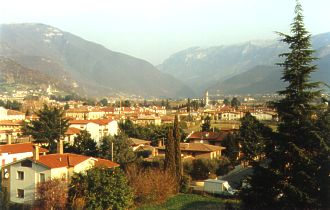
The foothill city of Bassano del Grappa lies about 50km northwest of Venice, set on a plateau that reaches all the way to the seashore. However, immediately behind the city the steep foothills of the Alps rise to 1,700 meters above sea level, thereby forming an extensive southern wall giving all the advantages for thermic flying. Surprisingly, the southerly situation doesn't bring to Bassano that real bomb flying that it would seem to at first glance. The vertical layering of the air is very stable in this type of situation and southern streaming pushes damp air off the ocean into the region, which, in an inversion layer, forms a haze sometimes so dense at night that you can't see the stars and in the daytime you can't see the landing strip from the runway. The evolution of the thermic situation is subdued by the haze and the ceilings usually don't reach over 1,500m above sea level.
Po Following the exchange of air masses and change in the direction of current from North to northwest a dramatic change occurs. Understandably for the better. Many pilots will ask,"What do you do with a North wind on a runway turned South?". No worries. As all of the runways are perfectly shielded by the high mountain mass, the determining factor at takeoff become convection. And in such a situation it is a damn pronounced factor. Striking ascendant currents often reach values over 8m/s and ceilings tend to be over 2,500m above sea level. Leeward convection is very strong and markedly turbulent, in short a mess, and a hard fight - nothing for beginners. If a pilot waits it out in Bassano for that fresh weather, lives by the rule that the worst death is from fear and if he doesn't care that what he does in his pants will in the next instant fall behind his neck then is rewarded by that enchanting view of the snow-covered Alps, with the memorial at the peak of Monte Grappa far below him.
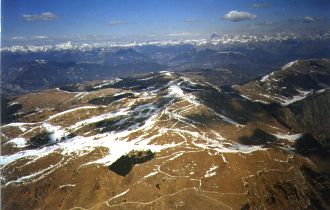
The photo was taken from height of approximately 2,400m above sea level. I lost about 150m of altitude before I even managed to point the camera in the strong turbulence, and had I not had it on a long band I would have lost it on several occasions.
|
The digital memory of Flytec that day, 20.3.1999, recorded a maximum height of 2,534m above sea level and ascents of 9m/s.
How to Get There Without Getting Lost
If the pilot doesn't want to spend more time travelling than flying, he'll select a route exclusively along highways and get into the fasted vehicle he's got at his disposal. An Austrian highway permit valid for ten days comes to 72 shillings, but is also available at gas stations on the Czech side of the border for 220 Czech Crowns. Highway tolls in Italy vary depending on the particular section of road you're travelling. It is always necessary upon entering a toll section of the highway to purchase a ticket from the automat, because without it you risk an unpleasant fine upon exiting the highway. The tolls aren't drastically high, for example, from the Italian border at Villach almost to Venice, which is just about the entire Italian section of the trip, comes to about 370 Czech Crowns.
Moravian pilots favor the Vienna, Graz, Klagenfurt, Villach, Udine, Padova, Bassano route. For Czech pilots it is better to follow the Linz, Salzburg, Innsbruck, Brenner, Bolzano, Trento and Bassano route with a possible variation through Munich.
Choose what route he may, it's always necessary to travel toward Bassano del Grappa at co-ordinates N450°45.809' E11°44.074'. Upon arriving at Bassano all that remains is 5km northeast to the village of Semonzo.
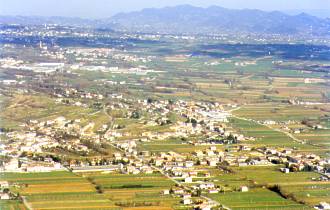
This last 5km can, however, for the pilot arriving for the first time, turn into an unpleasant roaming through strange, twisting village roads. I searched long for an exact way that would without mistake guide the tired pilot all the way to the campground itself. Signs forb "Cima Grappa" show the right direction, but are missing at a few key places. Signs for the valley of Santa Felicita crop up also only sporadically, so ther really only exists one way, other than GPS, and that is to follow the notices at intersections with the name "Dalla Mena".
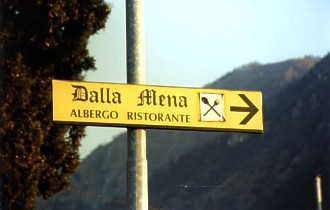
The Campground at The Hotel Dalla Mena
Should the eye of the pilot, following many hours of travel, fall upon the Hotel Dalla Mena at the end of the Santa Felicita valley, his heart will eap with joy. Right next to the hotel is a free camprgound, N45°48,775' E11°45.313', in which is immediately recognizable spoken Czech, sometimes German and occasionally even Polish is heard.
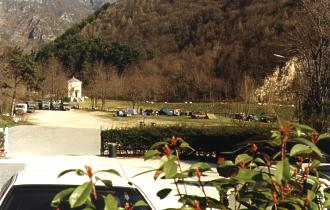
The effect of the high mountains is already felt in the valley of Santa Felicita. Soon after sunset the katabatic streaming causes a very cold valley wind, running down off the cooling steep mountain slopes down through the valley. Turnaround takes place only after sunrise, when following the warming of the slopes, the direction of the current changes and it becomes apparent that convection has begun working.
|




